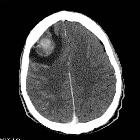hypervaskularisierte Leberläsionen

Riesenhämangiom
der Leber: Obere Reihe (axial, koronar, sagittal) arterielle Kontrastmittelphase, unten portalvenös. Man erkennt gut die zunehmende Auffüllung von peripher nach zentral. Daneben bzw. ventral davon noch eine ähnlich große Zyste ohne Kontrastmittelaufnahme. Koronar links eine weitere kleine Zyste.

Metastasen
eines Nierenzellkarzinoms im Magen und in der Leber. Die arterielle Kontrastmittelphase zeigt die Hyperperfusion. Es fanden sich multiple weitere Metastasen an anderen Stellen.

Teenager with
a liver lesion. The diagnosis was focal nodular hyperplasia.

Choriocarcinoma
• Choriocarcinoma liver metastases - Ganzer Fall bei Radiopaedia

Hypervascular
liver lesions • Liver metastases from lung primary - Ganzer Fall bei Radiopaedia

Hypervascular
liver lesions • Hepatocellular carcinoma - Ganzer Fall bei Radiopaedia

Hypervascular
liver lesions • Hepatic carcinoid - Ganzer Fall bei Radiopaedia

Hypervascular
liver lesions • Focal nodular hyperplasia - with embolization - Ganzer Fall bei Radiopaedia

Hypervascular
liver lesions • Hypervascular hepatic metastases of renal cell cancer (CEUS) - Ganzer Fall bei Radiopaedia

Primary
hepatic perivascular epithelioid cell tumors: imaging findings with histopathological correlation. A 35-year woman with hepatic angiomyolipoma. The non-enhanced CT (a) showed a round well-circumscribed homogeneous hypoattenuated mass in the caudate hepatic lobe. On the arterial phase (b), the tumor demonstrated significantly heterogeneous enhanced surrounded by a dysmorphic vessel (arrow). On the portal venous (c) and delayed (d) phases, the enhancement decreased, but still showed higher density compared to the surrounding liver. The MRI (e, T1WI in-phase; f, T1WI out-of-phase; g, fat-suppressed T2WI) images showed hypointense on T1WI and hyperintense on T2WI. Note the fat showed signal intensity decreased on out-of-phase image as compared with in-phase image and low signal intensity on fat-suppressed T2WI (arrow). On hepatocyte-specific agent enhanced MRI (h, arterial phase; i, portal venous phase; j, delayed phase; k, hepatobiliary phase), the tumor showed the same enhancement on arterial, portal venous and delayed phase images as CT and marked hypointensity of the tumor relative to the liver parenchyma on the hepatobiliary phase image. Ultrasound (l) showed a well-defined heteroechoic mass in the liver

Primary
hepatic perivascular epithelioid cell tumors: imaging findings with histopathological correlation. A 39-year woman with hepatic lymphangioleiomyoma. The non-enhanced CT scan (a) revealed a round well-defined homogeneous hypoattenuated mass in the right hepatic lobe. On the arterial phase (b), the mass demonstrated significantly heterogeneous enhanced surrounded by a dysmorphic vessel (arrow). On the portal venous (c) and delayed (d) phases, the mass became homogeneous, but still showed higher attenuation compared to the background liver. The MRI scan (e, T1WI in-phase; f, T1WI out-of-phase; g, fat-suppressed T2WI; h, DWI) showed hypointense on T1WI, hyperintense on T2WI and high signal intensity on DWI. The enhancement pattern on dynamic contrast-enhanced MRI (i, arterial phase; j, portal venous phase; k, delayed phase) was corresponded with CT. Note the vessel around the tumor on T2WI and arterial phase images (arrow). Ultrasound (l) showed a round, well-defined hyperechoic mass with a cribriform appearance in the right lobe of liver

Liver tumors
• Focal nodular hyperplasia - with embolization - Ganzer Fall bei Radiopaedia

Focal nodular
hyperplasia • Focal nodular hyperplasia - Ganzer Fall bei Radiopaedia

Focal nodular
hyperplasia • Hepatic hemangiomas - focal nodular hyperplasia - Ganzer Fall bei Radiopaedia
Hypervascular liver lesions may be caused by primary liver pathology or metastatic disease.
Differential diagnosis
Primary lesions
- hepatocellular carcinoma (HCC)
- most common hypervascular primary liver malignancy
- early arterial phase enhancement and then rapid wash out
- rim enhancement of capsule may persist
- hemangioma
- benign; most common liver tumor overall
- discontinuous, nodular, peripheral enhancement starting in arterial phase
- gradual central filling in
- enhancement must match blood pool in each phase, or not a hemangioma (i.e. similar to aorta in arterial, portal vein in portal phase, etc)
- small hemangiomas (<1.5 cm) may demonstrate "flash filling" - complete homogeneous enhancement in arterial phase (no gradual filling in)
- focal nodular hyperplasia (FNH)
- bright arterial phase enhancement except central scar
- isodense/isointense to liver on portal venous phase
- central scar enhancement on delayed phase
- hepatic adenoma
- arterial phase: transient homogeneous enhancement
- returns to near isodensity on portal venous and delayed phase image
- primary hepatic carcinoid
- background liver disease (cirrhosis)
Metastases
Although the majority of liver metastases are hypodense and enhance less than the surrounding liver, metastases from certain primaries demonstrate an increase in the number of vessels, resulting in a hyperechoic ultrasound appearance, and arterial phase hyperenhancement on CT or MRI which washes out on delayed scan (c.f. hemangioma which does not show wash out). The primaries typically include:
- renal cell carcinoma (RCC)
- thyroid carcinoma
- neuroendocrine tumors
- leiomyosarcoma
- choriocarcinoma
- melanoma
- breast cancer
- colonic carcinoma
- ovarian cystadenocarcinoma
Other secondary lesions
- failing Fontan circulation
See also
Siehe auch:
- Leberhämangiom
- Regeneratknoten der Leber
- hepatozelluläres Karzinom
- Karzinoid
- Lebermetastasen
- Leberadenom
- Chorionkarzinom
- Phäochromozytom
- Leiomyosarkom
- Insulinom
- Schilddrüsenkarzinom
- Lebermetastasen malignes Melanom
- Fokale noduläre Hyperplasie
- noduläre regenerative Hyperplasie
- Angiomyolipom der Leber
- liver lesions
- hypervascular hepatic metastases
- Lebermetastasen bei Mammakarzinom
- hepatic carcinoid metastasis
- Lebermetastasen bei Nierenzellkarzinom
- Leber Primovist FNH
- bile duct adenoma
- hyperdense Leberläsionen
- Lymphangioleiomyom der Leber
und weiter:

 Assoziationen und Differentialdiagnosen zu hypervaskularisierte Leberläsionen:
Assoziationen und Differentialdiagnosen zu hypervaskularisierte Leberläsionen:















